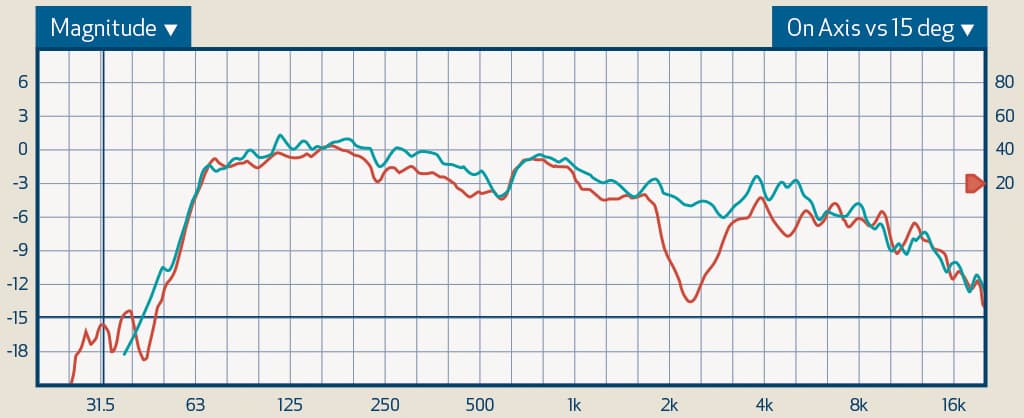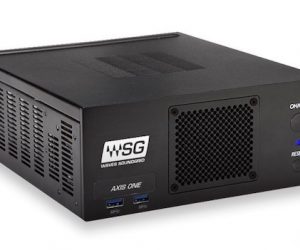
How Do You Measure Up? Part 2: Off-Axis is Your Ally
Sometimes it’s not all right in front of you. A speaker’s off-axis and power response has more effect on your measurements than you might think.
Your mum hands you a sack of second-hand Lego and tells you that buried amongst the green boards, rubber wheels and decapitated heads are all the pieces to build a pirate ship. All you have to do, she figures, is separate the ship bits from the miscellaneous pieces and you’re good to go. “Oh, and by the way,” she trails off as she closes the door, “I threw the box out years ago.” Along with any idea of what the ship looked like and instructions for how it’s supposed to go together. Thanks mum!
You set down your Han Solo figurine and rumble through the pieces trying to pick out ship-looking bits. Your best guess is that it’s majority brown but other than that, if it isn’t a sail and doesn’t have ‘pirate’ written on it, you’re just speculating. After half a day you end up with a mountain of ‘maybes’ and a handful of ‘definitely nots’, but aren’t any closer to seeing the ship through bricks.
Much like that sack of Lego, when you measure in a complex acoustic environment the response of the loudspeaker is jumbled in with the effects of the surrounding environment, creating a puzzle that can be very difficult to solve.
BUILDING BLOCKS
To get the most out of your measurement system, you need to be able to break down and analyse what you see. In the case of real-world loudspeaker measurements, it’s about being able to separate the response of the loudspeaker system from the contribution of the room and the surrounding acoustic environment. If you know what the loudspeaker looks like in a reflection-free environment, it’s much easier to determine the acoustic environment’s effects. It also simplifies the process of deciding which parts of the trace should be equalised and which should be left alone.
Now if this seems daunting, don’t worry, I was hopeless at measuring PA systems in reverberant environments for a long time; often just turning the computer off and doing it the old-fashioned way. I just couldn’t see how the measurements correlated to anything I was hearing. But once I had a detailed look at speakers in a controlled environment, things became much easier to decipher.
IT’S PLANE, ON REFLECTION
The previous article (Part I, in Issue 107) demonstrated it’s actually fairly easy to spot a discrete ground reflection in your measurement trace (both speaker and mic on stands) when compared to a ground plane measurement (speaker and mic on ground). But when you take that loudspeaker indoors you will have plenty of other things to deal with. Apart from the loudspeaker itself, and interactions between drivers within that loudspeaker, you have interactions between multiple loudspeakers, coupling between the loudspeakers and surrounding areas, reflections, reverberation, resonances… the list goes on.
To begin solving this puzzle we need to know our speaker more intimately than what we can garner from a simple ground plane measurement.
First, we’ll revisit the on-axis response of the loudspeaker in a little more detail. Believe it or not, this is actually the least important measurement, but usually the one people care about most. Next we’ll look at the off-axis response of the loudspeaker; what the loudspeaker is doing in all directions, not just directly in front of it. It will give us some clues about how the speaker reacts when measured at different points in the room, how it behaves in a reverberant environment and how it interacts with other speakers in an array.
Much like the first article, having a better understanding of this doesn’t just help you read measurements, it improves your practical understanding of audio theory.
CUT DOWN THE MIDDLE
Let’s start with the on-axis response. While more loudspeakers are shipping with ‘flatter’ responses than in the past, without measuring them yourself, you’ll never know the actual response. For this experiment to be truly effective, you’ll want to measure a loudspeaker you’ll actually use in the field. If you can’t get hold of one, don’t despair, you’ll still learn a thing or two with any speaker.
A bit of a recap from the last article. First, get away from reflections. Outdoor measurements away from obstacles will usually work best, provided wind is not a factor. If inside, you’ll need a very large space — you’re living room will be too small. Second important step, label your measurements so you know what you’re comparing later on.
Now, take the on-axis measurement using the ground plane method outlined in the last article. Once you’ve got a nice reflection-free ground plane measurement, you want to capture some traces at a measurement distance you would generally use when measuring that speaker in the field. It will give you a practical reference for later use. Make sure you label those measurements with the distance from the speaker and store them.
Now look at that measurement. Is it flat? Does it have a smiley face curve, some big dips or peaks, or a large boost in the high frequencies? Where do the low frequencies and the high frequencies roll off? Get a good idea of what the speaker is doing.
The most common mistake after realising the speaker doesn’t have a ruler-flat response straight out of the box, is to think the manufacturer got it wrong and start rebuilding the loudspeaker preset to make it look better. If that’s you, then stop right there! On-axis response is only one very small piece of the puzzle. Having helped build loudspeaker presets, I can tell you it’s no trivial process. Unless you understand the complex world of loudspeaker and crossover design, it’s best to leave it alone. That being said, there are plenty of speakers out there that aren’t perfect. In a case where you consistently notice something in the field (e.g. you consistently put a filter at 3kHz), then you may be able to use those measurements to help you refine that filter.
OFF-AXIS BEHAVIOUR
Next, you’ll need to understand how the speaker behaves off-axis, which is much more important than the on-axis response when you’re measuring in a reverberant environment. We’ll start by doing some polar measurements and then discuss something very important called power response.
Recognising dips in polar responses (both vertically and horizontally) can be really handy when analysing traces in the real world. Manufacturers usually supply polar responses, which are a great reference provided the data is accurate and you know how to read them. Some of the world’s most popular loudspeaker systems have terrible off-axis responses, so you cannot take it for granted. You’ll want to have your own accurate measurement that you can pull up to compare with real-time measurements.
Polar measurements are usually done in a couple of different ways; by rotating the microphone around the loudspeaker, or keeping the microphone stationary and rotating the loudspeaker on the spot. The second method requires less space, so we’ll go with that.
First, start with the same setup as your on-axis measurements. You need to be in the ‘far field’ for polar measurements, so get as far away from the cabinet as you can. At least four metres away is great, but the distance will be cabinet size- and space-dependent. If the cabinet is symmetrical in the plane you’re working in (either horizontal or vertical), you’ll only need to measure one half.
If you want to measure the vertical polar response, simply lay the cabinet on its side (making sure it’s pointing straight out, not lying on an angle) and re-measure. Every 10 degrees should be fine, try less if you’re really keen. Most manufacturer’s data is measured in five degree increments but the increments don’t really matter. The aim is to give you a reference of how the speaker behaves off-axis. If the speaker response exhibits a big dip at a certain point, you should expect to see that when you measure from the same angle in the field.
Next time you’re measuring that loudspeaker, pull up those measurements you’ve stored and labeled and see if they relate to what you’re seeing. Now when you see the dip in the field you’ll know it’s an artefact of the speaker/crossover design rather than a reflection, or something else, causing it. Let’s look at an example. Here’s a two-way speaker measured in the vertical plane, both on-axis and approximately 15-degrees off-axis.
Some of the world’s most popular loudspeaker systems have terrible off-axis responses, so you cannot take it for granted

Note the big dip that appears around 2kHz, due to the misalignment of the low and high driver. This will show up in varying degrees when measuring at the same angle in the field. Now you know it’s there and can identify it in a measurement, you’ll be less inclined to reach for the EQ to try and fix it.
FEEL THE POWER
Now let’s talk about Power Response — something you’ll probably never actually measure, but you’ll need to understand the concept. When we measure in a reverberant environment we see both the direct sound (relative to the angle we’re listening at), plus the energy in the reverberant field. The energy in the reverberant field — which we call the power response — is made up of the sum of all the radiated sound from the loudspeaker in all directions.
Picture your loudspeaker with an imaginary sphere around it. If you were to measure the frequency response at every point on that sphere and then calculate the sum of all those measurements, that would give us the power response.
If you put that loudspeaker in a highly reverberant environment and take measurements in the reverberant field — i.e. beyond the critical distance: the point where the level of the loudspeaker’s direct sound equals the sound from the reverberant field — the power response curve would dominate the measurements, not the on-axis direct response. This is because the reverberant field is being excited by sound travelling in all directions from the loudspeaker, not just what comes out the front.
This is why the power response is so important. You can have a perfectly flat on-axis response, but if the power response is not smooth — and you’re in a reverberant environment — those bumps and dips will generally show up in your measurements and you’ll hear them colour the sound of your PA system. As you see and hear these, if you start to correct them, what you’ll actually be doing is starting to degrade the on-axis response and you’re left with a transfer function that may look flat but will certainly not sound that way.
SPHERE OF INFLUENCE
So what does the power response look like? Sound becomes more omni-directional as wavelength increases, relative to the size of the sound source. So if we’re measuring on an imaginary sphere surrounding the loudspeaker, the lower frequencies will generally show up in all the measurements, while the high frequencies will tend to show up more in front of the loudspeaker. This results in a power response that is tilted downwards, from low to high frequencies, but with various dips and peaks, usually based on interactions between the drivers within the cabinet.
If you measure a PA in a highly reverberant space, your measurement system does a good job of giving you a fairly clear picture in the high frequencies. But it cannot remove all the additional low frequency energy from the reverberant field. You’re not just measuring the on-axis response but a combination of the on-axis response and the power response.
Since the power response is supposed to be tilted downwards and dominates the measurement as you move further into the reverberant field — if you equalise it flat again, you’ll actually be tilting the on-axis response upwards from the low to the high frequencies, resulting in a harsher sounding system.
Also, if the power response is not a smooth slope, but has some fairly large peaks, those peaks will generally show up in a reverberant field measurement. As you remove them, you will again adversely affect the on-axis response to compensate. Now some of you may ask, “but if the energy in the reverberant field is contributing to the response, shouldn’t flattening it off give us a more ‘linear’ room response?” The problem occurs when we actually have to listen to the PA system. Our ears deal quite differently with the initial direct arriving energy from the loudspeaker and the late arriving, time-smeared energy from the reverberant field.
So you’re probably wondering where you can get your hands on the power response for your loudspeaker of choice. Well, unfortunately, you’re probably out of luck. Most loudspeaker companies don’t even calculate it let alone release it, choosing to work from polar responses instead. So while you may not be able to ‘see’ the power response in a graph, you’ll need to understand the concept and realise that it’s just not what comes out the front of the loudspeaker that counts when you’re measuring inside.

POLAR CAPS
Compare these two graphs above:
If you’ve never looked at a polar measurement in this form: they display frequency, level in dB and degrees off-axis in the one graph. In the first polar we can see that it’s very omni-directional at 100Hz then becomes more directional as it increases in frequency before becoming wide again just below 500Hz. Above this the coverage narrows before becoming wide again at 1kHz. It narrows again before stabilising about 3kHz.
Compare this to the second polar. This is also very omni-directional at 100Hz but quickly stabilises below 500Hz and remains fairly consistent right up to beyond 10kHz. Now let’s look at some frequency response measurements. Both have been normalised so they have a flat on-axis response. We can see that in the first example, these bumps in the polar response around 500Hz, 1kHz and 4kHz can be seen in the frequency response plots off-axis.
If we measured this loudspeaker off-axis and then tried to flatten the trace, we would be adversely affecting a large portion of the room. You can see the second loudspeaker behaves very similarly throughout the coverage area apart from an off-axis dip just above 1kHz. Any adjustments to this loudspeaker off-axis would make much more predictable results through the rest of the listening area.

Now, imagine in a perfect world that your venue has filled with people and the reverberant energy has diminished significantly. If the on-axis and off-axis responses are similar you will have a system that will only require minimal adjustments to compensate for the change in the reverberant field.
Now you have a better understanding of your loudspeaker, the fun part begins. Take your loudspeaker and put it close to walls, put it in different sized rooms, on the floor, above the floor, put it in dead spaces, reverberant spaces and keep on measuring. Notice how much those responses change. Notice which parts stay the same. Ask yourself — how has the response changed placing it near a wall? Can I see the reflection from the wall in the measurement? Can I see any loading in the low frequencies when placed near the wall or floor? Can I see the room modes? If I’m in a reverberant room, can I see the additional energy in the lower frequency region? If I move off-axis, do any of those dips correlate with what I saw in my off-axis measurements?
Let’s finish with an example. Look at this trace and ask yourself what you’d do.

Now take a look at this trace compared to a semi-anechoic response (in blue) and ask yourself the same question.

While it doesn’t tell you what to do next, this does give us a much clearer picture of what part of the trace can be trusted, and which parts are obviously being affected by the room or the position of the microphone. Whatever decision we make next will be better informed than if we didn’t know how the loudspeaker performed outside the room.
As you do this more, you’ll not only end up with a more intimate understanding of your loudspeaker, but you’ll gain a better understanding of the acoustic interactions around you, which is the ultimate goal if you want to start getting the most out of your systems.
Happy measuring!
Special thanks to my good friend Benoit Cabot for helping provide some of the data.
















RESPONSES